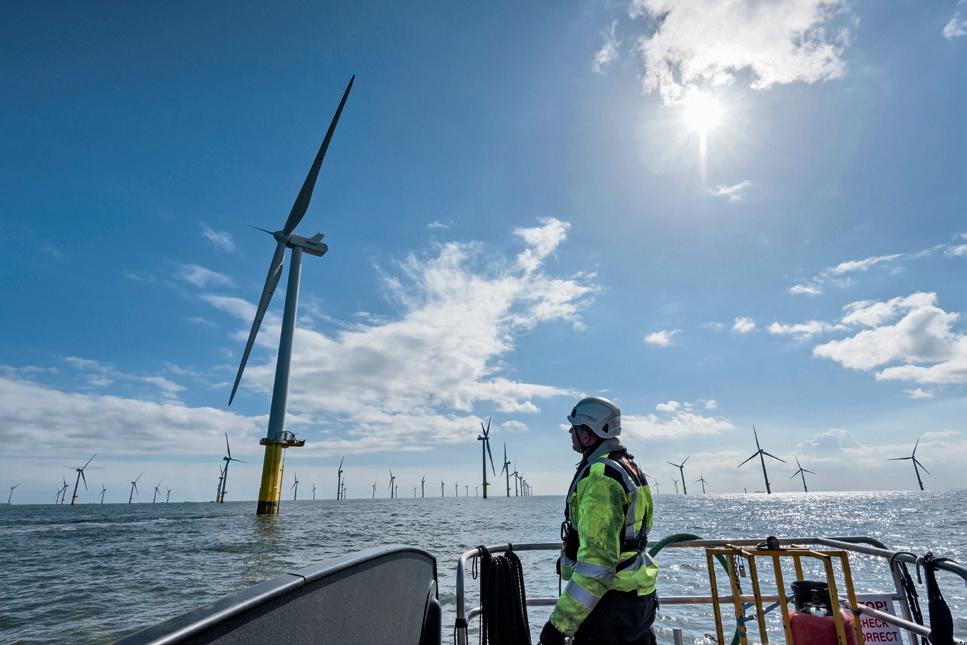
4 minute read
Offshore Success Relies on Strategic Maintenance
Offshore Success Relies on Strategic Maintenance
by David Futter
Advertisement
When it comes to wind turbine maintenance, owners’ goals can generally be summarized as follows: predict faults early to reduce unplanned downtime, increase overall profitability, and extend the lifecycle of the turbine. Fault prediction, the most essential element of the maintenance planning process, is facilitated by smart, cloudbased Condition Monitoring Systems (CMS).
CMS enables wind park owners to implement a knowledge-based maintenance strategy; a careful combination of reactive, preventive, and predictive maintenance. Reactive maintenance is simply waiting for a part to break down before replacing it. Preventive maintenance estimates interval times between repairs based on historical data. Predictive maintenance uses real-time data to predict faults before they occur.
An appropriate combination of the three approaches depends both on the affected part and the criticality of the fault. It also requires the ongoing acquisition and analysis of vast amounts of relevant data. Data is collected by specialist CMS hardware. In order to derive useful knowledge, however, it must be stored in a location accessible for analysis. This analysis is what converts raw data - first into information, and then into knowledge upon which predictive maintenance decisions are based.
The collection of CMS data in wind power takes place via internet-enabled measurement systems with a circular maintenance process (figure 1). This process begins with the establishment of a baseline, whereby CMS data is then periodically collected and reviewed for any deviations from the baseline. Should changes or alarms occur, then appropriate maintenance can be planned and carried out. The final step is to then reestablish a new baseline, following maintenance actions.

Figure 1: Wind Power Maintenance Cycle
Credit: Bachmann electronic GmbH
Due to access restrictions, the cost of repairing a wind turbine is often significant. When turbines are located offshore, those costs are amplified. Offshore maintenance requires complex logistics to access the turbine, as well as safe weather conditions for the offshore transfer of the maintenance team.
To reduce these costs, turbine owners must be able to plan and combine maintenance actions. Early detection of a developing fault through smart Condition Monitoring provides the solution. Early warning signs become visible through a combination of IoT-enabled hardware and cloud-based software.
When it comes to hardware, a variety of sensors collect and collate data to a local CMS edge device, which performs some post-processing before transmitting data to the cloud. This integrated approach ensures that data collection is completely synchronized, avoiding the need for multiple connections. Any bottlenecks in the data transmission process are thereby removed, which also improves cyber security. Transmitting data via one secure link (as opposed to a multitude of individual systems) offers turbine owners a safer alternative.
Once the edge devices have delivered data to the cloud server, it can be further processed by CMS monitoring software. The data is then used by analysts to search for trends and anomalies, and to inform maintenance teams of any required action. Results are shared in the cloud server, making them accessible online from any authorized device. Maintenance teams are then better able to plan repairs, including ordering the correct parts and setting an optimized time schedule.
There are multiple benefits of employing IoT measuring devices together with cloud-based analytics. First, any control-relevant CMS data is shared locally with the turbine control system, streamlining the application of collected data. Second, IT overheads remain low due to fewer connections and less external data.
As well as improvements to cyber security, all data becomes available in one place, providing a holistic overview of not only individual turbine performance, but the performance of every turbine in the fleet. Results are available anywhere, anytime, which enhances communication between analysts and maintenance teams. Finally, cloud-based systems allow turbine owners to outsource specialist tasks, like Vibration Analysis, to third party experts.

Figure 2: Service engineer on the way to make repairs
Credit: Monty Rakusen, gettyimages
Many wind park owners choose to outsource CMS processes, particularly data analysis, due to the economies of scale available. Through certified Condition Monitoring centers, dedicated teams of trained specialists are available 24/7. With a constantly growing database from many connected turbines, these specialists can derive in-depth knowledge faster and more accurately than any individual park owner examining the performance and condition of single turbines.
In simple terms, this means turbine faults are detected and dealt with earlier, before they become significant and cause major damage. Working with independent experts also gives park owners more OEM independence, all while allowing site teams to focus on power generation and maintenance.
To begin Condition Monitoring, turbine owners must first define possible faults, or failure modes, and their impact on machine lifetime; smart CMS hardware can then be installed to specifically monitor these failure modes and provide relevant data to the cloud server. The actual monitoring and analysis can be outsourced to specialist third party providers.
Condition Monitoring is a constantly developing process; prediction accuracy increases as more knowledge is accumulated. The growing fields of offshore and floating wind offer a world of untapped data that will further improve maintenance strategies, deliver more accurate predictions, and help prolong the life of wind turbines.

Figure 3: Specialist condition monitoring experts perform ongoing data analysis
Credit: adobestock / Gorodenkoff
David Futter is Product Manager for Bachmann Monitoring GmbH. Bachmann services thousands of installations worldwide with a complete package of individual and customized DNV-GL certified solutions.




